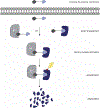Targeted protein degradation: elements of PROTAC design
- PMID: 31004963
- PMCID: PMC6930012
- DOI: 10.1016/j.cbpa.2019.02.022
Targeted protein degradation: elements of PROTAC design
Abstract
Targeted protein degradation using Proteolysis Targeting Chimeras (PROTACs) has emerged as a novel therapeutic modality in drug discovery. PROTACs mediate the degradation of select proteins of interest (POIs) by hijacking the activity of E3 ubiquitin ligases for POI ubiquitination and subsequent degradation by the 26S proteasome. This hijacking mechanism has been used to degrade various types of disease-relevant POIs. In this review, we aim to highlight the recent advances in targeted protein degradation and describe the challenges that need to be addressed in order to efficiently develop potent PROTACs.
Copyright © 2019 Elsevier Ltd. All rights reserved.
Figures


References
-
- Ciehanover A, Hod Y, Hershko A: A heat-stable polypeptide component of an ATP-dependent proteolytic system from reticulocytes. Biochem Bioph Res Co 1978, 81:1100–1105. - PubMed
-
- Hershko A, Heller H, Elias S, Ciechanover A: Components of ubiquitin-protein ligase system. Resolution, affinity purification, and role in protein breakdown. J Biol Chem 1983, 258:8206–8214. - PubMed
Publication types
MeSH terms
Substances
Grants and funding
LinkOut - more resources
Full Text Sources
Other Literature Sources

